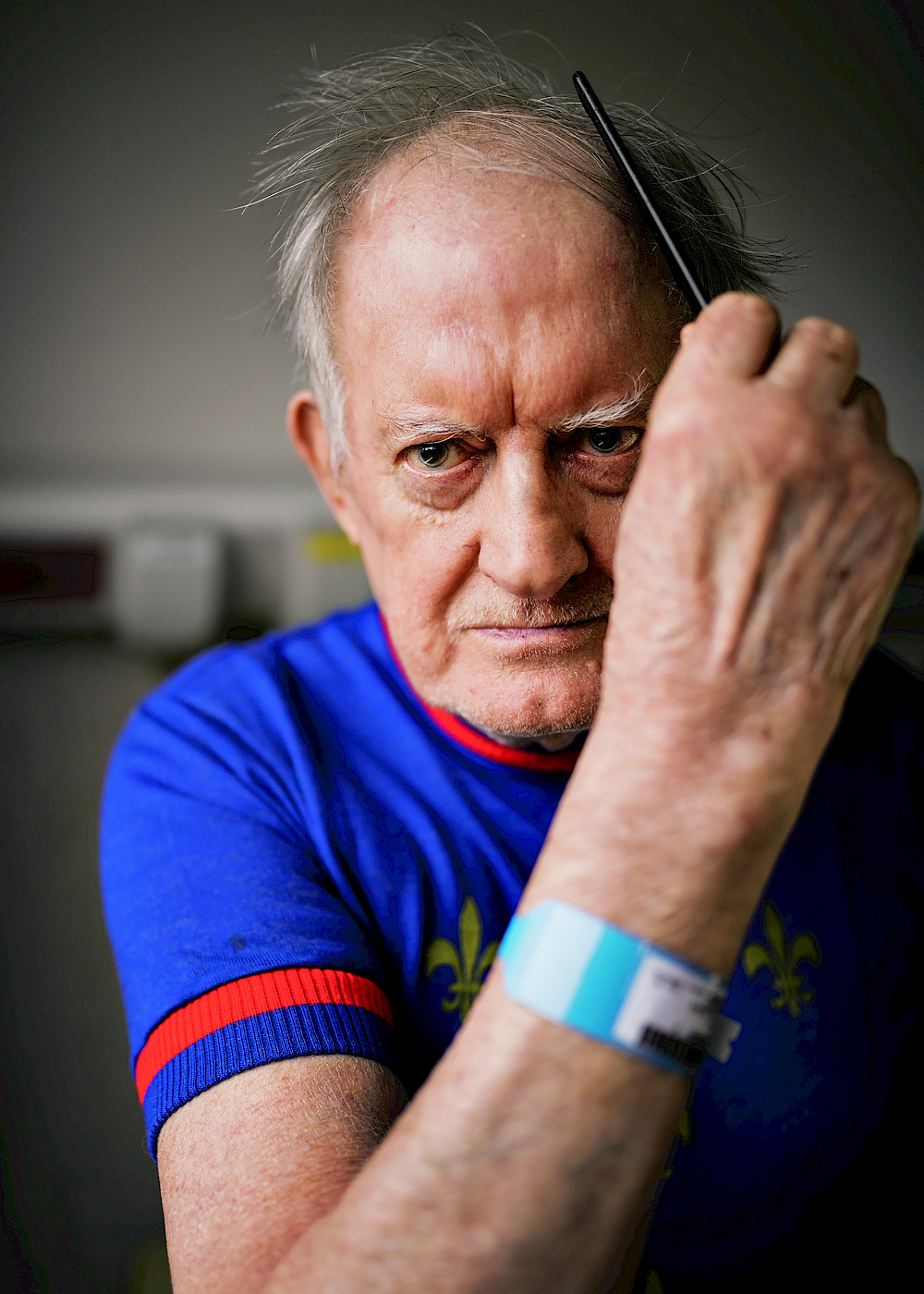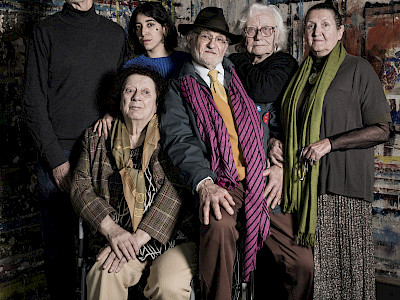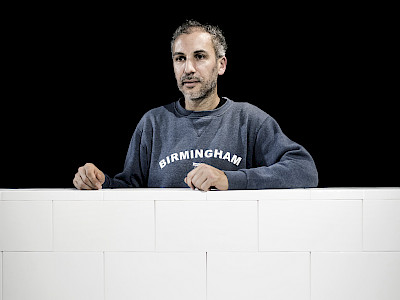28.05 — 01.06.2024
Will we still know love in the last stage of our lives? When theatre maker Mohamed El Khatib developed an artistic practice in retirement homes, transforming them into art centres, he was moved by the intimate lives of older people. In previous productions, El Khatib, a master in documentary art, has developed an exceptional practice that brings personal stories to the stage. With this new creation, La vie secrète des vieux, he accompanies participants between 75 and 102 years old to tell us their love stories. Facing up to ageing means confronting the gaze of society while observing one’s worn-out body and its creeping threat to autonomy. Still, love remains, and desire can be accompanied by reinvented sexuality. This desire no longer conforms to performance or social pressure but develops its own rhythm and fragile intimacy, sometimes just as intense. Through encounters with the elderly, we discover their experience of love and how they still make love. This landscape of third-age love presents a nostalgic picture of our romantic assessments and a promise that desire can nestle in the fragility of our lives, to the very last moment.
I’ve got time to take my socks off now
Mohamed El Khatib, to make La vie secrète des vieux [The Secret Life of the Elderly] you applied the singular method you’ve developed that informs your documentary theatre, and went out and met elderly people. What made you want to do this?
The Covid “crisis” revealed the serious dysfunctions in care homes, which were picked up by the media. The marginalisation of the issue of old age resurfaced with a vengeance. A section of the population, people who are physically, socially, psychologically and politically vulnerable, is being excluded, which is intolerable. But I think there’s always an urgent need to artistically revisit what has been relegated to a blind spot in society. More than anything I’m sorry that the people who died en masse in care homes weren’t able to tell their stories, and all too often that’s true for the elderly in general. Care homes are built on the outskirts of cities where people are shut away, and the morbid and inhuman dimension of this medicalised system of dependency is all the more striking for me because by 2050 more than 60 % of the French population will be over 70. Also my work fundamentally focuses on forgotten or hidden bodies, which means that ever since I started working in theatre, I’ve been presenting “strange” bodies on stage. I’m interested in the bodies of the working classes who are absent from contemporary stages, and in this particular instance I’m interested in worn out bodies, old bodies, bodies that people think are no longer capable of achieving anything physical – sadly one of the main criteria for accessing performance venues.
Why are you particularly interested in their erotic lives?
When you envisage old age, it’s always from a perspective of dependency, memory loss, the need for medical care, what people are no longer able to do or less able to do on their own; never from the point of view of desire or vitality, and even less so of what you can do more of with age! As soon as you talk about old people, the idea of physical or cognitive decay predominates, along with no longer being useful, decline, the collective imagery of an endless end of life… That’s why quite early on I had the idea of making a film about the love lives of the over 70s. My first impulse was to ask about old age from the perspective of the essence of life: desire, love, things you don’t expect to get an answer to! The creation of the first film project at a retirement home in Chambéry, entitled Le grand âge de l’amour [The Great Age of Love], culminated in the plan to make this show because when I was going around care homes meeting all these people to ask them questions about desire and their love lives, I became aware of the scale of the space for projection that these simple conversations recreated for them. It was deeply moving. For me, it opened up an unexpected landscape of being elderly and in love today, including all the hidden questions that interested me like taboos, ill-treatment and infantilisation.
What were the problematic things about this that you picked up in the “landscape of their love life”?
Oddly, we noticed that their children could be intrusive out of a concern to “protect” them or sometimes, more mundanely, for inheritance reasons. Sometimes, without wanting to, they put a damper on loving relationships being formed… And, in this relief, the “mountain”, the main cause of satisfaction for me, is to observe that at this age love is actually being reinvented. With this generation, we’ll discover that there are other ways to make love, that the range is large, and that the relationship with the body, over time, is different. As Lombardo says in the show: “I’ve got time to take my socks off now” (smile). Some of them rediscover the joys of liberated sexuality while others, applying the same freedom, take themselves off the “seduction market”. Our inherited patterns, our viewpoints, which are particularly influenced by religion, and our lack of conversation about love in old age are completely shaken up. Very often, after a first marriage to please their parents and satisfy religious requirements, in their second love life, after a death or divorce, another relationship involving pleasure comes about. In any case, a freedom emerges that didn’t exist, and by the way the desire that’s rediscovered isn’t just sexual because desire is never-ending.
How did you manage to get them to trust you enough for them to confide in you?
The same as with the children in La Dispute… They’re both ages in life when you can say exactly what you like. People say what they think, they’ve got nothing to prove, they don’t have to perform. What they say is authentic and emancipated. It’s a privilege of age and it’s very touching. In their new attachments, I experienced the equivalent of what I could do with the children of divorced parents, when they were able to say things to me like: “I prefer my dad to my mum.” (laughs)
How did you work with these people and what stage design do you envisage for them?
Using their uninhibited words, it was interesting to note down what you can do at this age and the values that it can encourage, such as solidarity, but also and above all to get to the core of what these people who are going through old age are experiencing in their own flesh. It was important to put them at the heart of the device.
That’s why, again, I didn’t want to use professional actors: what old people have to say is already marginalised enough. But also because I didn’t want just anyone to speak on their behalf, I preferred them to come themselves and stand up for their ambitions and desires. Working with them is very easy because they want to do it, and the project represents a real challenge: activating these bodies on stage, bodies commonly shut out of a space that is valued symbolically and by the media, putting them back into the spotlight, and so taking care of these people. The stage design will be designed to match exactly what they can physically do; one of the performers, Jacqueline, is in wheelchair, for example. They can’t stand for too long. At the moment, I really like the idea of a multipurpose room, a ballroom floor, a waiting room, a place where you meet and do activities together, so I envisage recreating the kind of space where they can socialise and meet up with friends.
- Interview by Mélanie Drouère
Mohamed El Khatib has set up an art centre in the Résidence Sainte Gertrude in The Marolles. You can read the interview (in French) he gave to Sylvia Botella on this subject here.
Presentation: Kunstenfestivaldesarts, Théâtre National Wallonie-Bruxelles
Concept and creation: Mohamed El Khatib | With alternating cast members depending on their longevity: Annie Boisdenghien, Micheline Boussaingault, Marie-Louise Carlier, Chille Deman, Martine Devries, Jean-Pierre Dupuy, Yasmine Hadj Ali, Salimata Kamaté, Jacqueline Juin, Jean Paul Sidolle | Dramaturgy and artistic coordination: Camille Nauffray | Scenography and artistic collaboration: Fred Hocké | Video: Emmanuel Manzano | Sound: Arnaud Léger | Technical manager: Jonathan Douchet | Production manager: Gil Paon | Interviews: Vanessa Larré, Vassia Chavaroche, Marie Desgranges | Artistic collaboration and support for rehearsals: Mathilde Chadeau, Vassia Chavaroche, Elliot Delvaux | Occupational therapists: Virginie Tanda, Paul Ceulenaere, Anne-Marie Di Giambattista, Vinciane Watrin | Administration: Cécile Boursier | Press: Nathalie Gasser | Set photography: Yohanne Lamoulère
Production: Zirlib | Coproduction: Théâtre National Wallonie-Bruxelles, Festival d'Automne à Paris, Points communs - Nouvelle scène nationale Cergy-Pontoise-Val d'Oise, La Comédie de Genève, Théâtre national de Bordeaux en Aquitaine, Théâtre national de Bretagne (Rennes), Tandem Scène nationale d’Arras-Douai, MC2: Grenoble Scène nationale, La Comédie de Clermont-Ferrand Scène nationale, Théâtre Garonne Scène européenne (Toulouse), Festival d’Avignon, Théâtre du Bois de l'Aune (Aix-en-Provence), Équinoxe Scène nationale de Châteauroux, Théâtre de la Croix-Rousse (Lyon), La Coursive Scène nationale de La Rochelle, Espace 1789 - Saint-Ouen, Théâtre de Saint-Quentin en Yvelines Scène nationale, Le Channel - Scène nationale de Calais
Residencies: Le Mucem - Marseille, CIRCA La Chartreuse
Zirlib is supported by the Ministère de la Culture - DRAC Centre-Val de Loire, by the Région Centre-Val de Loire and by the Ville d'Orléans
Mohamed El Khatib is an associate artist of Théâtre de la Ville in Paris, Théâtre National de Bretagne in Rennes and Théâtre National Wallonie-Bruxelles
Performances in Brussels with the support of the French Embassy in Belgium and the Institut français Paris as part of EXTRA, a program that supports French contemporary creation in Belgium




